London Fashions March 1888
By Mrs. Johnstone
The fashions of today are the fashions of the past, with slight but pertinent alterations. We owe many of our present inspirations to the perfect taste of that "Jolie Marquise bourgeoise" who, according to Marmontel, "avait eu la faiblesse de vouloir plaire au Roi, et le malheur d'y réussir (had the weakness of wanting to please the King, and the misfortune of succeeding)."
However corrupt the middle of the eighteenth century may have been, the upper classes in France had attained to a perfect taste, demonstrated by the elegance of dress and artistic refinement in furniture, a great deal of which was due to Marquise de Pompadour with her thorough savoir vivre.
Under her auspices, the Gobelins tapestry and the Sevres china were declared royal. Many of the designs for the porcelain were sketched by Boucher, and the charming bouquets and garlands of flowers in the rich brocades of her epoch were either designed by herself or this same Boucher, who in 1776 died suddenly, brush in hand, alone, in the satin-draped boudoir-atelier where the gay world went to congregate.
His works remain, though for a time his personality was forgotten. By-and-by the gay Marquise also was laid out of sight, the common fate of poor humanity. Louis XV bore her loss with equanimity, if it be true that, watching the rain on the day of her funeral, he remarked, carelessly enough, "Madame n'a pas de bon temps pour son voyage (Madam does not have a good time for her trip)."
The Magic of Color
One of the most beautiful silks prepared for the spring Drawing Rooms of 1888 is of a design which bears the name of the Marquise de Pompadour; the reproduction of a historical silk; the shot ground is in cream and the revived pomme (a shade in fashion then), the best of all greens by candlelight.
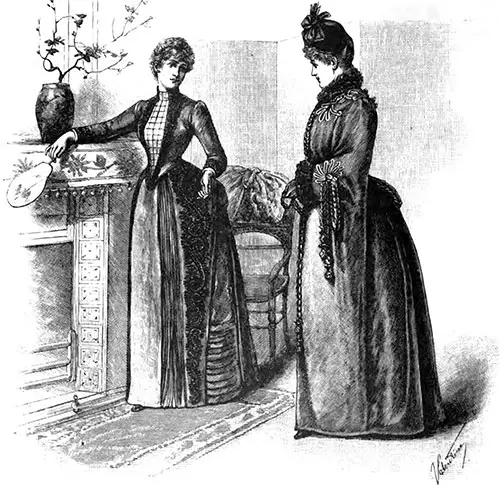
Spring Indoor and Promenade Costumes
It is striped with silk and satin and brocaded with roses tied with the blue true lover's knot, characteristic of that period, while the foliage is of the pomme tone. This color, as its name implies, is the exact tint of a green apple.
Accurate and thorough knowledge of color is a valuable acquirement to a woman who would dress well. The most beautiful harmonies are those who have the most consonance.
To demonstrate this, Bernardin de Saint Pierre tells how the ancients personified the Sun as the daughter of Air, who, on the banks of Cephisus, repeated the last word she heard; just as most of our greatest colorists have repeated their harmonies.
Symphonies duplicated are essential in women's dress, with some contrasts, which Nature applies with a lavish hand, as in the color of animals and the earth, green leaves and flowers. The field this year is a wide one for never has the fashionable range of colors been more beautiful or broader.
The shades of brown are borrowed from beaver and bark; the greys are in several variations; the blues range from electric to sky-blue and turquoise, including the deep, dark, bright, Royal blue, which we delighted to honor as "Alexandra blue" when the Princess of Wales came to us, over twenty-five years ago, a bride.
Terre cuite is as full and rich in the shade as a Devonshire cliff; the vieux rose is lighter and more tender than of yore; so is the crevette, which matches a young prawn fresh from boiling.
The old-fashioned pink has come back to us, and the old oyster-white; grenat, cardinal, and the brilliant poppy red are also worn. All these colors are to be found in the Failles Desirees, with their coarse cords; there is nothing more à la mode.
Shot grounds are the fashion, but thus early in the season, it would seem that, with one exception, there is not to be a mixture of fabrics. Plain silk and brocade are to be worn apart; wool and silk are to be disunited.
Gowns made with some fourteen yards of brocade, and nothing else requires merely a little lace trimming; and for evening wear a muslin fichu, copied from that well-known picture of poor unfortunate Marie Antoinette, who was born on the day of the Lisbon earthquake and was through life ill-fated.
Headwear
It is familiar to most of us, the large head-dress with pearls, feathers, and satin; the miniature about her neck strung on pearls and the deftly-folded muslin fichu over the square-cut bodice.
What the exception alluded to is shot velvet and shot silk, both made of the identical silk; "douillets" they are called, in mixtures of red and green, red and brown, blue and red, and so on.
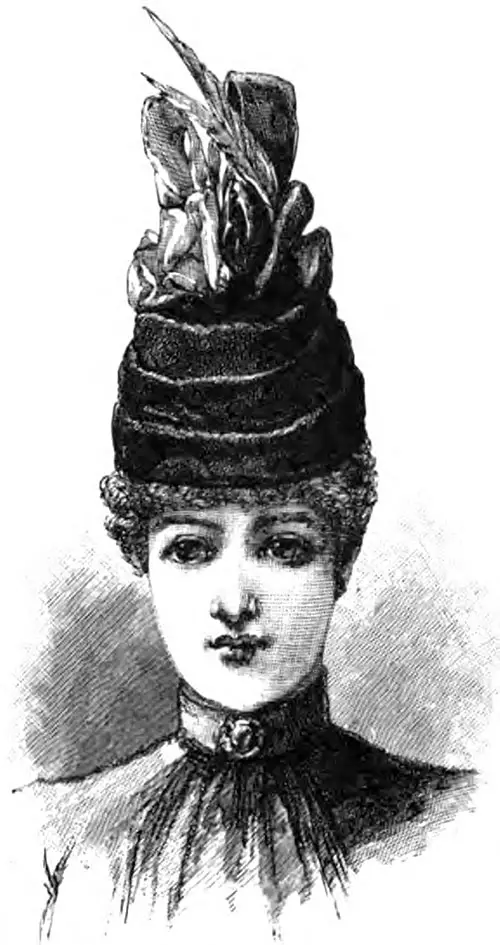
Toque In Velvet Or Straw
Stripes are still most popular, but generally appear on a shot ground; a good example intended for the Court dress of a young married woman has shot silk, and satin stripes in red and pomme, pink and grey, and other equally delightful mixtures, with positive spots of the dominant color on the stripes.
These soies changeantes, as the French call them, have a different aspect in every light.
The principal feature in the new brocades is the wheat, barley, oats, and wildflower designs which run through them all, bringing back the scent of fresh pastures, which comes with the hopes that spring generates.
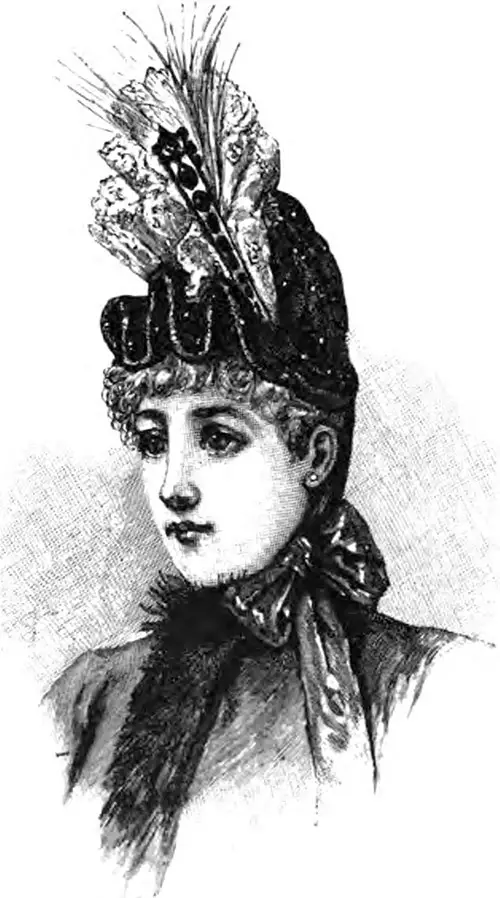
Beaded Crinoline Bonnet
For morning wear there are some excellent striped and shaded silks in two colorings; "Ombre Pékin" is the technical term; these are the most serviceable silks made, for they keep their good looks to the last.
The new satin stripes have picot edges; they look as if they were ribbon laid on. This style is effective in broad bands of red and black, used for mantles joined chevron fashion down the back, and have plain red sleeves, for Dame Fashion is playing many freaks with sleeves this year.
Another class of stripe used for trains is the "damas," all of one color, with a lappet-like design having curved edges rather close-set, but of the exact tone of the ground, a triumph of weaving.
Bridal gowns, where cost is of no moment, are made of white, thick silk, with bunches of silver lilies of the valley scattered all over it.
Excellent black silk is one of the necessities of a well-dressed woman's wardrobe, and the firm of Bonnet et Cie, have produced some of the best-looking and best wearing of our century. One of many good examples is the "Perfection of Silk," a thick, rich make resembling Radzimir, both sides alike.
It will not split, fray, nor wear greasy; its name is printed on the selvage. Black silk should not feel gummy but be light and full in hand. A test of goodness is to crease the silk on the cross and then pull it the contrary way; the fold should smooth quickly and disappear.
It requires deliberation of choice to buy wisely and well, but the silk we describe will bear all these tests. The black should be of a mat or dull tone now.
Braided Gowns
Braided gowns are much worn this spring, and the illustration of Messrs. Debenham and Freebody's spring costumes shows a new form of the braided panel, which widens towards the waist, falling over a tucked side breadth.
The front of the gown has the plain Empire pleat, flanked by many small folds. The color, grey, serves to show up the black braiding which is applied to the revers on the habit bodice and the cuffs.
The outdoor jacket, to match the dress, has the cuffs and collar also braided, and large black buttons at the waist.
Small designs very closely worked are considered in the best style, for they cannot be so easily copied. However, there is no reason why, acting on Ruskin's oft-repeated advice, women should not do this work themselves, or, at all events, give out the work to be done by gentlewomen less favored by fortune.
The many artistic designs prepared to iron on to the material to be ornamented considerably lessen any difficulties attached to braiding.
March Outerwear
March winds are proverbially treacherous, and a light but warm cloak is always needed. The material of the accompanying design is velours de laine with a pile longer than velvet, shorter than plush, made in wool not silk.
It is bordered with feather trimming and gold and black interplaited cord, matching the embroidery, is carried around the throat. Note the beautiful conventional flower on the sleeve, from which fall ends of the cord. The garment is easily slipped on and off.
New Bonnets and Hats
New bonnets are generally the first item in spring raiment to which attention is drawn, and there is everything to tempt the buyer. The toque is so generally useful and becoming that it is always worn, but its form alters.
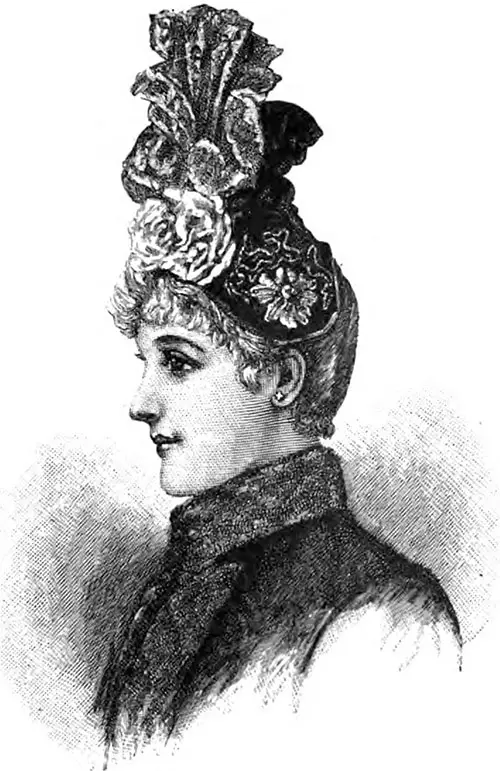
Tulle And Velvet Bonnet
The first of the millinery illustrations of what Mtne. Louise and Co., of Regent Street, are introducing this season, is made of folds of the material matching the dress to be worn with it, or it can be arranged on a straw turban, hidden by crosscut bands of velvet, which is a material worn now all the year round.
The hat is not at all high in itself, but an appearance of considerable height is produced by the trimming placed on the top of the crown. It consists of loops of ribbon, some pure white, some of two distinct shades of mousse, thrust through with white quills tipped with silver arrow-points.
At the back, the brim is cut in a battlement. Hats are worn in town and country, not only by girls but by women of forty summers, on many occasions when they would not have been permitted a few years ago although by no means to the exclusion of bonnets.
Young women affect stringless bonnets, like the one we illustrate, made of black tulle embroidered in bullion gold like a uniform. Our model is cut up in a point at the back, and, untrimmed, the bonnet itself is of tiny proportions.
The bow at the top gives, however, all desirable height and importance. It is composed of a black lace lappet tied into the required form, the edges run with fine wire so that the loops keep up well. The Chantilly lace is intermixed and solidified, so to speak, with loops of piece-velvet.
A wreath of soft full-blown roses, composed of a mixture of muslin and velvet, borders the brim and stands erect so that there is ample space for the display of curled hair.
Full-blown roses are also employed on bonnets in small close wreaths, from which spring the inevitable tuft of feathers or bows that surmount the lace. A jet-embroidered bonnet had a pink wreath so arranged, from which rise lace bows, osprey, and jet sprays.
Very narrow ribbon, about a quarter of an inch wide, runs in tulle tucks closely together, is employed for the crowns of bonnets. A red one of this kind was trimmed with a mousseline de soie lappet, worked in gold and straw, the ends standing upwards, and supported by bows of ribbon; roses bordering the brim, and the narrow strings coming from the back were fastened with small gold-headed pins.
Feathers would seem to be most worn on hats, and flowers on bonnets: acceptable news to the Plumage League and to those who have the welfare of the little birds at heart.
There is every variety in the form of the brims of bonnets, which often rest on the head, as is the case in the last of our illustrations. This head-gear is composed of fine black crinoline, worked all over with jet ladybirds.
It has three distinct flutings wired into form in front, and an upstanding bow of white lace intermixed with osprey, and a black jet pin; the white and black harmonized by contrast.
The hats which are distinctively new have brims that widen in front, and more closely resemble the sailor shape than any other. Some of these brims turn upwards like an inverted saucer.
A good example is made in an open-work crinoline, heavily beaded, caught up at the back with a butterfly bow of yellow ribbon, blended on the crown with white, carrying out the tones of the loose asters and marguerites which nestle in the side of the crown, and overshadow it as though they grew there or had been but freshly gathered.
The more closely artificial flowers approach to nature the more fashionable they are, and their manufacture is most carefully carried out and considerably improved consequently.
Shaded glacé ribbons are employed in millinery and long streamers coming from loosely-tied bows hang at the back of many hats.
Nothing as yet has satisfactorily replaced straw for spring wear. It is essentially English, and we export it largely, though often enough it returns to our shores with the cachet of a French name.
Coarse plaits with a glistening surface and the finest of all fine plaits are worn, and are dyed to match the tint of dresses; the trimmings carrying out any combination of tones required.
Uniformity is essential now, though the two sides of gowns are trimmed quite differently, and nothing goes in pairs. However, bonnets, gloves, stockings, parasols, muffs, whatever is worn, must accord well together, and correspond with the dominant tone of color.
Fastenings of Gowns and Mantles
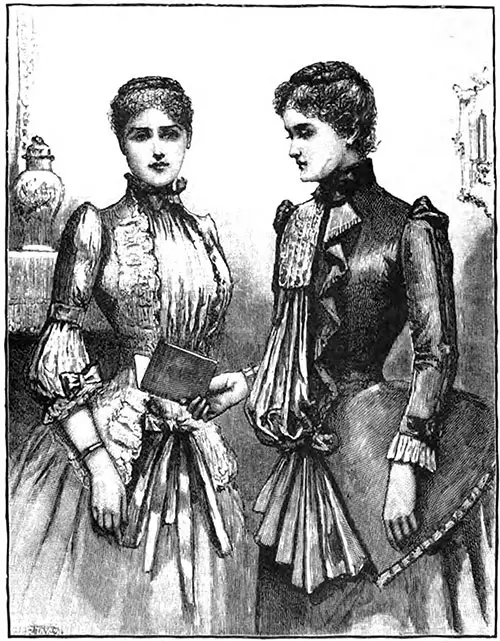
Bodice For Home Dinner Wear
The fastenings of gowns and mantles are undergoing a significant change; as often as not they are invisible. Dresses are being made only for outdoor wear which consists of a long coat or jacket of some dark tone; a petticoat in a lighter shade with a waistcoat attached.
The coat or jacket flies open without being secured, apparently, but in truth, the waistcoat starts only from the side seam of this garment, and virtually keeps it in its place.
Diagonal fastenings to bodices of all kinds are worn, also double-breasted openings, inspired by the Incroyable models which demand, of necessity, large and very visible buttons.
Next month the fashions in dressmaking will be more defined; meanwhile, as a picture is more eloquent than any verbal description, the accompanying sketches are left to tell their own story.
Johnstone, Violette, “March Fashions,” in The Woman’s World, Cassell & Company, Limited, London, Paris, New York & Melbourne, Volume I, No. 5, March 1888, p.233-236.
Note: We have edited this text to correct grammatical errors and improve word choice to clarify the article for today’s readers. Changes made are typically minor, and we often left passive text “as is.” Those who need to quote the article directly should verify any changes by reviewing the original material.
